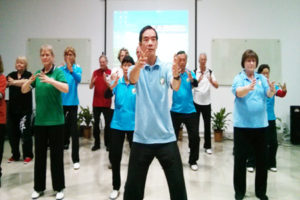By John M. de Castro, Ph.D.
“A growing body of carefully conducted research is building a compelling case for tai chi as an adjunct to standard medical treatment for the prevention and rehabilitation of many conditions commonly associated with age.” – Peter M. Wayne
Cardiovascular disease is the number one killer, claiming more lives than all forms of cancer combined. “Heart disease is the leading cause of death for both men and women. About 610,000 people die of heart disease in the United States every year–that’s 1 in every 4 deaths. Every year about 735,000 Americans have a heart attack.” – Centers for Disease Control. A myriad of treatments has been developed for heart disease including a variety of surgical procedures and medications. In addition, lifestyle changes have proved to be effective including quitting smoking, weight reduction, improved diet, physical activity, and reducing stresses.
Contemplative practices, such as tai chi and yoga, have also been shown to be helpful for heart health. In addition, mindfulness practices have also been shown to be helpful for producing the kinds of other lifestyle changes needed such as smoking cessation, weight reduction, and stress reduction. Tai Chi is an ancient practice involving slow motion smooth mindful movement. The reason that it has continued to be practiced by millions for centuries is that it has major mental and physical benefits. Modern research is verifying these benefits. Mindful movement practice has been shown to improve balance, self-concept, and attention span, reduce falls, boost the immune system and helps to relieve symptoms of arthritis, asthma, Parkinson’s disease, insomnia, even improve cancer recovery, and improve recovery from heart failure.
In today’s Research News article “The Impact of Tai Chi Exercise on Self-Efficacy, Social Support, and Empowerment in Heart Failure: Insights from a Qualitative Sub-Study from a Randomized Controlled Trial.” See:
or see summary below or view the full text of the study at:
http://www.ncbi.nlm.nih.gov/pmc/articles/PMC4866692/
Yeh and colleagues randomly selected and interviewed a sample of participants from a previous successful trial of tai chi for heart failure. This trial demonstrated that tai chi produced significant improvements in quality of life, exercise self-efficacy, and mood in the patients. In the prior trial patients were randomly assigned to receive either a 12-week tai chi intervention consisting of one-hour group classes held twice weekly, or an attention control group which attended education sessions twice weekly. At the end of treatment, a sub-sample of the participants were audio recorded answering a semi-structured interview on their heart condition and its impact on their lives, how the program helped them, and any negative effects. Themes were then classified using grounded-theory methods.
They found that both groups described improved self-efficacy to perform specific health behaviors and improved social support. In addition, the tai chi group described more global empowerment and perceived control of their health, a heightened or new sense of mindful awareness, greater calmness and less stress, greater reengagement in social activities, and improved strength, energy, flexibility, balance, decreased pain and stiffness, and overall endurance.
These qualitative findings support and extend the positive quantitative findings from the prior study and suggest that tai chi practice has many important benefits beyond the crucial health benefits. The tai chi participants felt more empowered, aware, and socially connected. These are important benefits that help the patient to feel in greater control of their lives and health and improve their quality of life. Since tai chi is a safe and gentle exercise with so many positive effects on heart failure patients, it should be strongly considered as part of the treatment for heart failure.
So, use tai chi for physical and psychological health after heart failure.
“patients with heart disease can benefit from traditional Chinese exercises. Not only may these exercises boost outcomes, they promote a better quality of life in patients with heart disease. As experts highlight, they’re generally safe for all ages and fitness levels. Exercises like tai chi require no special equipment and can be performed anywhere, including outside or indoors. So for patients who are unable to do more vigorous forms of exercise, traditional Chinese exercises may be a good option to promote better health.” – CardioSmart
CMCS – Center for Mindfulness and Contemplative Studies
This and other Contemplative Studies posts are also available on Google+ https://plus.google.com/106784388191201299496/posts
Study Summary
Yeh, G. Y., Chan, C. W., Wayne, P. M., & Conboy, L. (2016). The Impact of Tai Chi Exercise on Self-Efficacy, Social Support, and Empowerment in Heart Failure: Insights from a Qualitative Sub-Study from a Randomized Controlled Trial. PLoS ONE, 11(5), e0154678. http://doi.org/10.1371/journal.pone.0154678
bstract
Objective: To qualitatively explore perceived physical and psychosocial effects and overall patient experience associated with a 12-week tai chi (TC) intervention and an education group in a clinical trial of patients with chronic heart failure (HF).
Subjects and Methods: We randomized 100 patients with chronic systolic HF (NYHA Class 1–3, ejection fraction≤40%) to a 12-week group TC program or an education control. At 12-weeks, semi-structured interviews were conducted on a random subset (n = 32; n = 17 in TC, n = 15 in control), audiorecorded and transcribed verbatim. Two independent reviewers extracted information using grounded-theory methods for emergent themes. We explored similarities and differences in themes/sub-themes between the groups, and examined qualitative association with changes from baseline to post-intervention in previously reported quantitative measures (e.g., Minnesota Living with HF, Cardiac Exercise Self Efficacy and Profile of Mood States).
Results: The mean age (±SD) of participants was 68±9 years, baseline ejection fraction 29±7%, and median New York Heart Association class 2 HF. We idenitifed themes related to the patient’s experience of illness, perceptions of self, and relationship to others. Specific psychosocial and physical benefits were described. Common themes emerged from both groups including: social support and self-efficacy related to activity/exercise and diet. The tai chi group, however, also exhibited a more global empowerment and perceived control. Additional themes in TC included mindfulness/self-awareness, decreased stress reactivity, and renewed social role. These themes mirrored improvements in previously reported quantitative measures (quality-of-life, self-efficacy, and mood) in TC compared to control. Patients in TC also reported physical benefits (e.g., decreased pain, improved energy, endurance, flexibility).
Conclusion: Positive themes emerged from both groups, although there were qualitative differences in concepts of self-efficacy and perceived control between groups. Those in tai chi reported not only self efficacy and social support, but overall empowerment with additional gains such as internal locus of control, self-awareness and stress management. Future studies of mind-body exercise might further examine perceived control, self-efficacy, and locus-of-control as potential mediators of effect.









